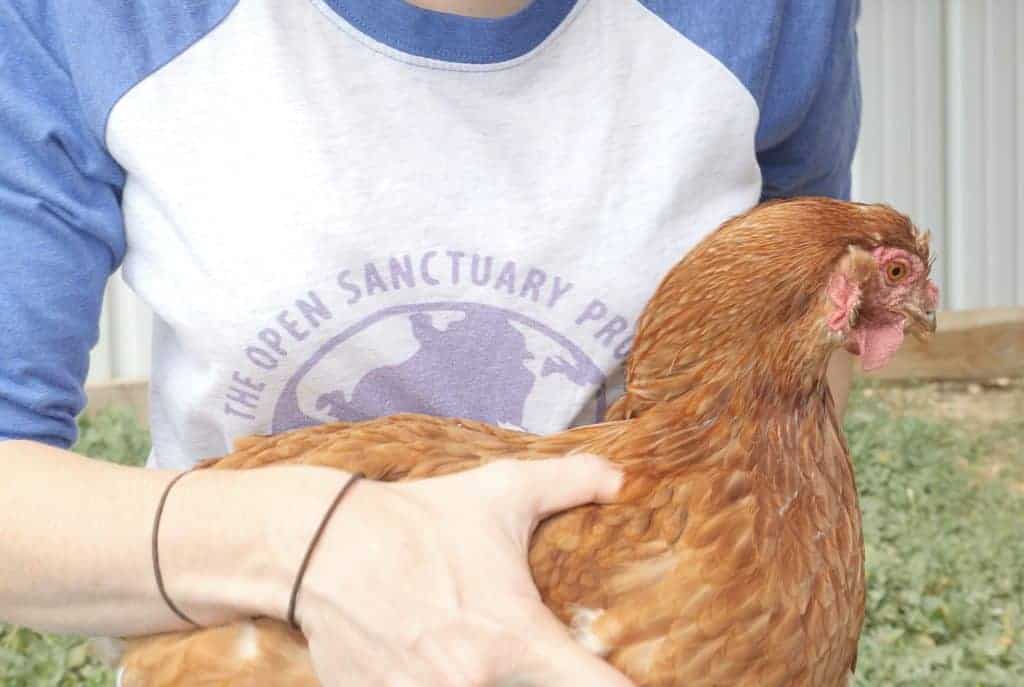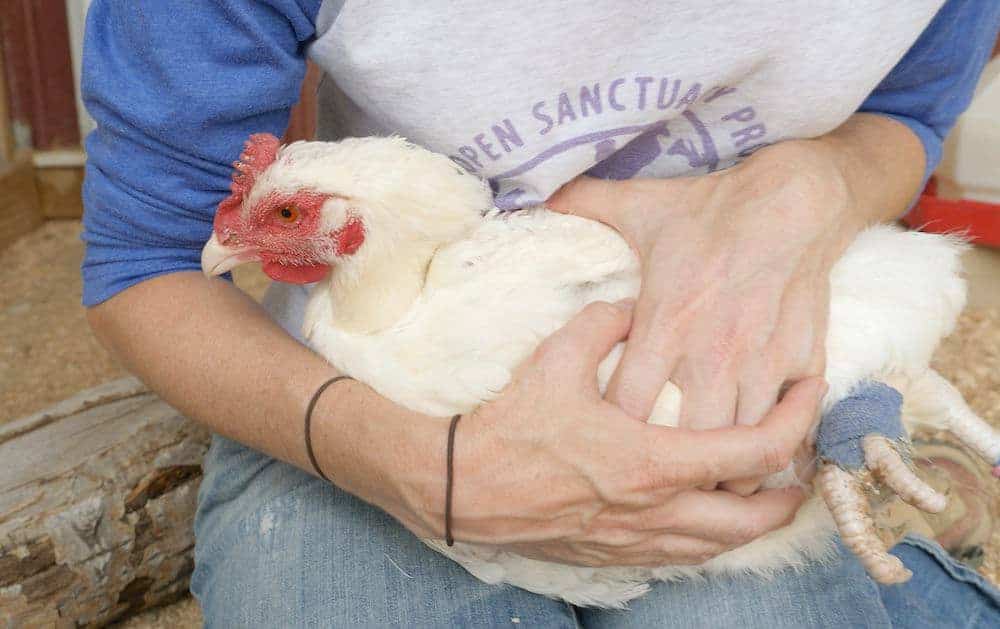
This resource has been partially reviewed and updatedA member of The Open Sanctuary Project’s staff has updated one or more sections within this resource. by a member of The Open Sanctuary Project’s staff as of November 1, 2021.
If you’re caring for chickens, it’s very important that you know how to safely handle and hold them. Some chickens are more receptive to being held than others, but you should practice a uniform, safe technique across the flock (with special consideration for health-compromised individuals) to keep all your residents happy and healthy. Regularly picking up a chicken will help familiarize them with the experience and can help make stressful events like health concerns, separations, and relocations a little less nerve-wracking.
If at all possible, have a veterinarian or care expert give you hands-on training for safe chicken handling! Failing to use appropriate technique can gravely injure chickens.
The Approach
When approaching a chicken, it’s essential that you do not chase them. Chasing is going to stress them out and may make them skittish around you. Lowering yourself down to their level and offering a little bit of food or a treat can help encourage chickens to want to spend time with you! Some more nervous chickens may still actively avoid your grip, so they might require a bit more coaxing.
The Pickup
Gently corral the chicken into a corner (herding chickens as a flock rather than singling out birds if possible) before you attempt to pick them up. When you are near enough, place your hands on the chicken- either place one hand on each side of their body, keeping their wings against them (this is more easily done if your hands are closer to the front of their body than to their wing tips), or place one hand in front of their chest to prevent them from moving forward, and then place one hand on their back to keep them still. Once the bird is still, place both hands firmly over both wings and around their body. You can then lift them towards you so that one side is held firmly against your body. This will prevent them from injuring themselves or jumping away from you. It’s okay if their legs are free as long as you have their torso and wings safely cradled. If the chicken gets a wing loose, put them down and try again. Flapping a wing while being held can result in a fractured wing.
NEVER pick up a chicken under their wings, or by their wings, feathers, feet, or neck. This is an unacceptable practice that regularly harms chickens. Do not allow anyone else to pick them up by their wings either! Some veterinarians have been known to do this as it is a standard practice in animal agricultureThe human production and use of animals in order to produce animal products, typically for profit. environments.
Once safely in your grip, you can gently pet them (never stroking against their feather grain!) and talk to them softly in order to calm them down and make them more comfortable with human handling. Be aware that there’s an optimal balance to be struck between holding them firmly, but not causing them injury. You always want the bird to be calm, not gasping or struggling under pressure, and feeling confident that they aren’t going to fall.
To perform a treatment or health examination, you can tilt the chicken slightly on their side and rest them in your lap. Always watch for signs of stress such as darkening of the comba fleshy crest on the head of the domestic chicken and other domesticated birds and wattles or open-mouth breathing and set them down if they are getting too stressed. For some individuals, even being only slightly tipped onto their side might be too much, in which case you will need to keep them upright (such as standing on your lap or on the ground while still being held in place). We recommend you avoid flipping a chicken on their back. While some may do fine in this position, chickens with certain health issues might have difficulty breathing when flipped onto their back. Large breedDomesticated animal breeds that have been selectively bred by humans to grow as large as possible, as quickly as possible, to the detriment of their health. chickens should never be placed on their back– doing so could result in respiratory distress or even heart attack.
To carry the chicken, keep them upright and held firmly and securely against your body- ideally with one wing against your body and the other under your hand or arm. For bigger chickens, it’s a good idea to put your free hand under their body to help support them. Be prepared to put them down if they start to struggle.
Setting Down A Chicken
When you set down a chicken, safely and carefully let their feet back onto the ground while continuing to keep their wings secure until you’re confident that they will gently leave you. Never throw a chicken! If it’s safe for their diet, you could give them a little extra treat after handling so they have a positive memory to associate the experience with.
Special Handling Requirements For Large Breed Chickens
While all chickens should be handled carefully, large breed chickens require additional consideration. Improper handling can easily cause injury and even respiratory distress or heart attack. When handing a large breed chicken keep the following in mind:
- DO NOT chase a large breed bird as it can cause stress that could trigger a heart attack or could cause them to overexert themselves and overheat. Instead, carefully corral them into a corner or other tight space so you can safely pick them up.
- Due to their size, large breed chickens are very prone to becoming stressed during restraint. It is imperative to watch them closely for any signs of stress and to be prepared to set them down if they becomes too stressed. Keeping them closer to the ground while being restrained will make setting them down quickly easier!
- If the chicken’s comb or wattles start turning purple and/ or they are severely open-mouth breathing, you should put them down immediately. Minor open-mouth breathing is not uncommon, but be sure to pay close attention to the chicken’s color, and watch for progression to more severe open-mouth breathing.
- It can be harder to keep a large breed chicken’s wing safely against their body. If they get a wing free, be sure to set them down to avoid injury to their wing.
- Large breed chickens should never be flipped on their back– doing so could result in respiratory distress or even heart attack. Instead, we recommend that you gently tip them slightly onto their side and keep them in your lap. For some individuals, even being only slightly tipped onto their side might be too much, in which case you will need to keep them upright.
- Never drop or toss a large breed chicken from any height- doing so could result in serious injury.
- Do not assume that anyone, even veterinarians, know how to safely handle large breed chickens. Always supervise their handling if not handling them yourself. If this is not possible, such as during certain procedures, be sure to have a conversation about safe restraint for large breed chickens.
- Although large breed chickens can be more difficult to restrain, regular health examination are still imperative! If someone has a hard time with restraint, it may be easier to have one person restrain while another performs the examination. You may also need to break up the examination in order to cut down on the amount of time they are restrained.
At The Open Sanctuary Project, unacceptable means that we cannot condone (or condone through omission) a certain practice, standard, or policy. See a more detailed explanation here.
SOURCES:
Basic Large Breed Chicken Care Part 2









